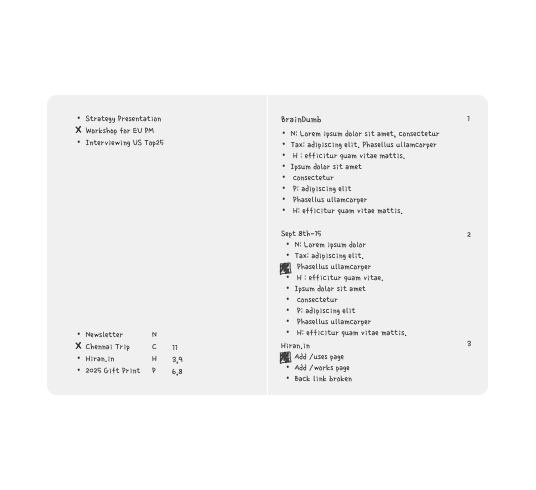For the past seven years, notebooks and journals have been my primary tools for planning and thinking. Despite experimenting with various digital tools, to-do apps, and iPad writing apps, I’ve found that analog methods remain most effective for me. Over the years, I’ve explored different formats and styles, ranging from long-form writing to Q&As and reflections. My current approach is a simple system that efficiently captures tasks and thoughts with minimal effort.

The Journal
*Tools should be readily available. Even minor inconveniences can lead us to choose alternatives, eventually resulting in chaos. *With this principle in mind, I use a FieldBook-like, small notebook with 64 pages. It’s compact and easily portable. This journal typically lasts me about 3–4 weeks, helping me focus on short-term goals.
I found traditional bullet-journal layouts complicated and overwhelming, so after trying complex templates, I’ve settled on a simpler approach. My current layout is a clean, one-column format, typically using a pen or pencil.
The Two-Sided Notebook Approach
I utilise the notebook from both ends. One side is dedicated to planning and tasks, while the other serves as a commonplace book for capturing ideas and reflections. This setup allows me to compartmentalise my planning and creative thinking. (Plus, tasks are often mundane and not particularly worth revisiting!)

The Power of the Index Page
Inspired by the Bullet Journal concept, I begin both sections of my notebook with a simple index page. I number notes rather than pages, as a single page can contain various topics. On the planning side, the index lists priority work projects, personal projects, and even travel plans. The commonplace side focuses more on topics, interests, and ideas.

Periodical Review
I aim to review my notes on weekends and reassess their significance. New ideas or logs are transferred to my Obsidian Digital Garden, while irrelevant items are struck off the index. For to-do lists, I create a fresh list from my project list without referencing the previous week’s tasks. I then cross-check with last week’s backlog and add any overlooked items. This approach stems from the belief that forgotten tasks are likely less important, though I acknowledge some mundane tasks still need attention.
Other Tools
While I value my analog system greatly, I don’t limit myself to it exclusively. I’m open to using more effective tools that help me achieve my goals. Google Calendar, Habit Tracker, Obsidian, Toggl, Trello, Linear, and others remain my go-to tools for larger and collaborative projects. [See Uses]
Miscellaneous
I preserve my notebooks and revisit them when seeking new ideas or insights into my thought processes. This is why I began keeping to-do lists separately, as they often contain routine tasks not worth revisiting. I also use a date-stamper on pages, enjoying the contrast of printed text among handwritten notes, typically applying it during note reviews.